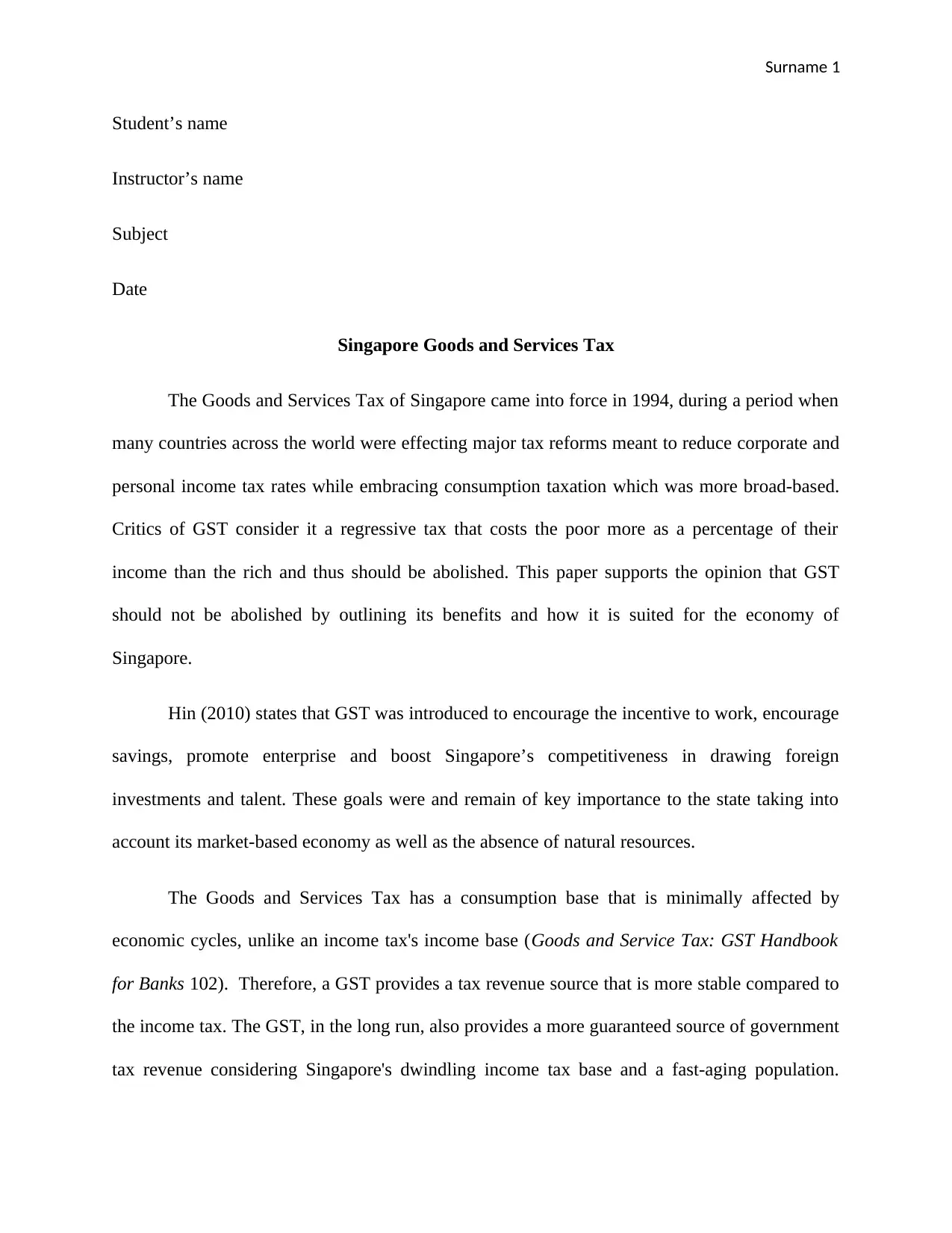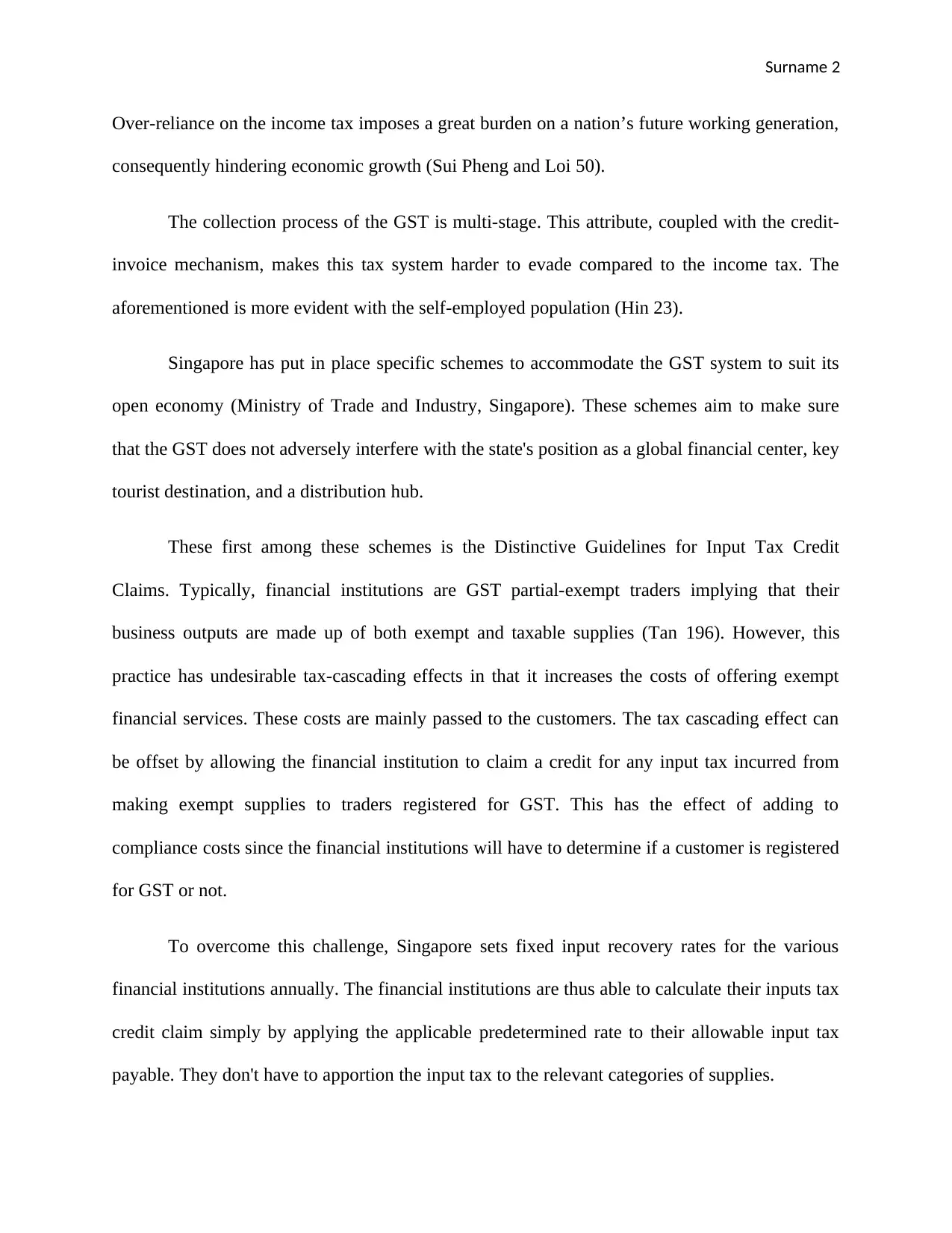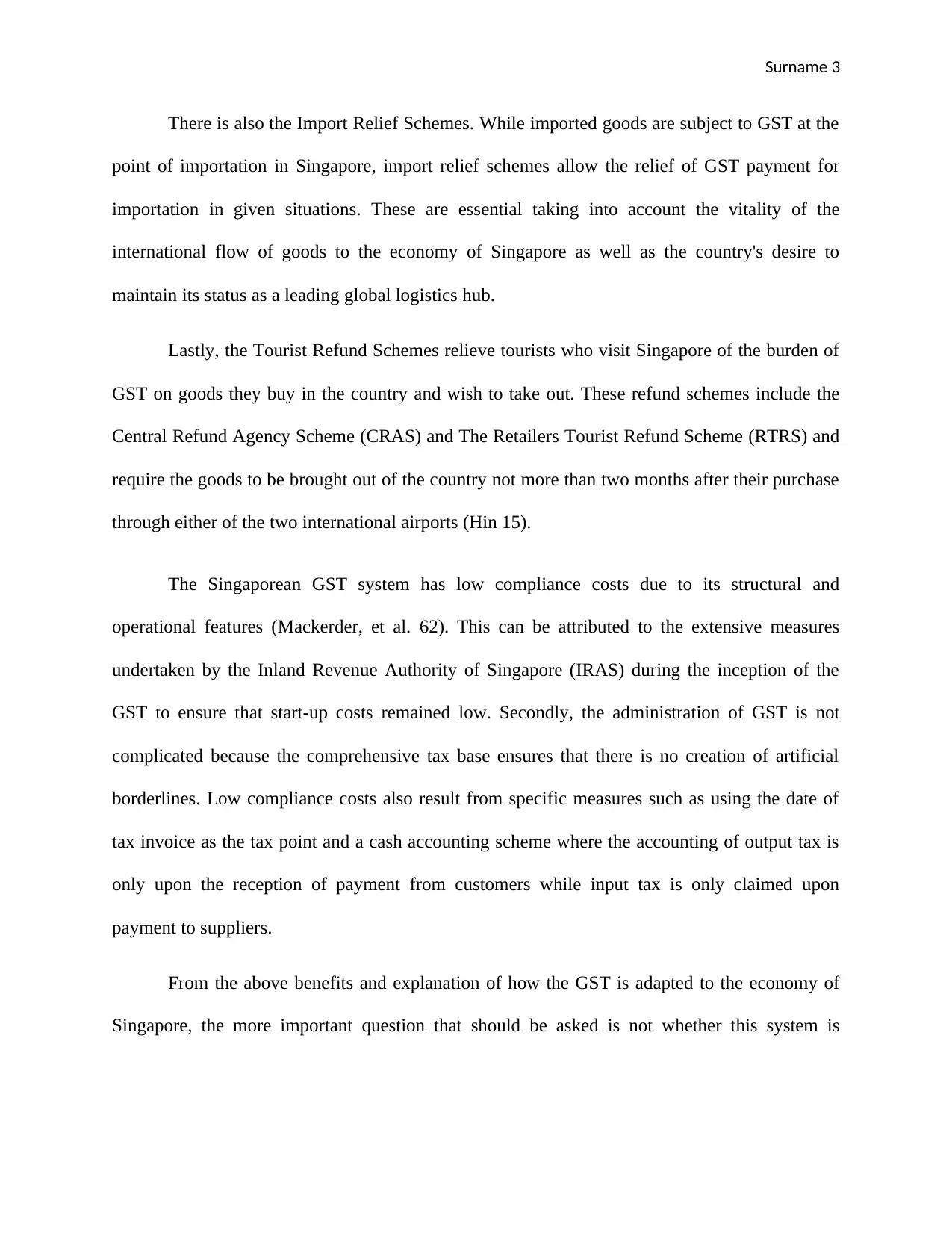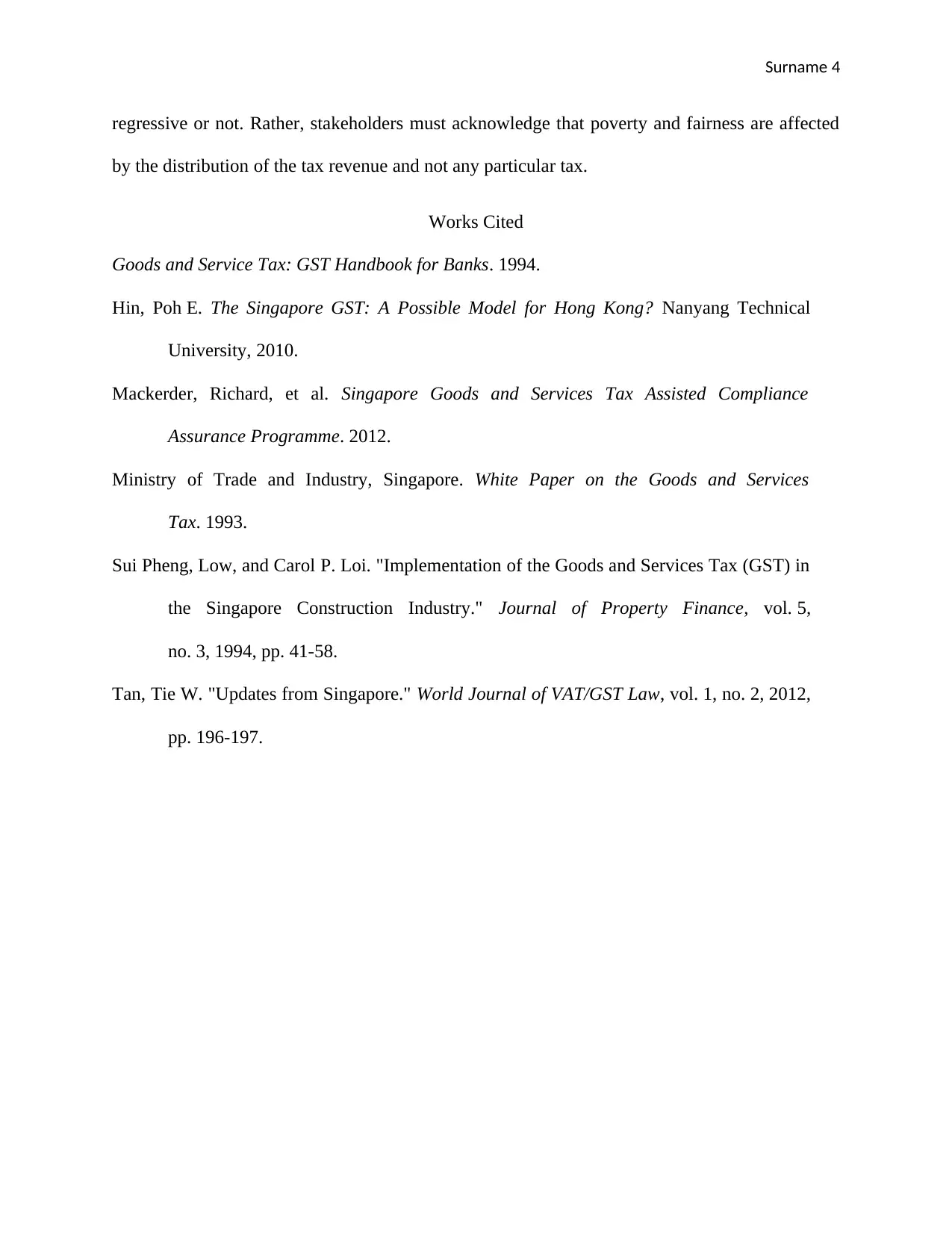An Economic Analysis of the Goods and Services Tax (GST) in Singapore
VerifiedAdded on 2022/08/27
|10
|1085
|19
Essay
AI Summary
This essay provides an analysis of the Goods and Services Tax (GST) in Singapore, introduced in 1994. It argues against abolishing the GST by highlighting its benefits, such as encouraging work, savings, enterprise, and foreign investment, crucial for Singapore's market-based economy. The essay explains how the GST, with its consumption base, provides a stable revenue source, especially with Singapore's aging population and dwindling income tax base. It details the multi-stage collection process, which makes it harder to evade compared to income tax. The essay also discusses specific schemes implemented to suit Singapore's open economy, including guidelines for input tax credit claims, import relief schemes, and tourist refund schemes. The GST's low compliance costs are attributed to measures taken by the Inland Revenue Authority of Singapore (IRAS). The paper concludes that the focus should be on the distribution of tax revenue rather than whether the tax itself is regressive. This assignment is available on Desklib, a platform providing AI-based study tools for students.

Surname 1
Student’s name
Instructor’s name
Subject
Date
Singapore Goods and Services Tax
The Goods and Services Tax of Singapore came into force in 1994, during a period when
many countries across the world were effecting major tax reforms meant to reduce corporate and
personal income tax rates while embracing consumption taxation which was more broad-based.
Critics of GST consider it a regressive tax that costs the poor more as a percentage of their
income than the rich and thus should be abolished. This paper supports the opinion that GST
should not be abolished by outlining its benefits and how it is suited for the economy of
Singapore.
Hin (2010) states that GST was introduced to encourage the incentive to work, encourage
savings, promote enterprise and boost Singapore’s competitiveness in drawing foreign
investments and talent. These goals were and remain of key importance to the state taking into
account its market-based economy as well as the absence of natural resources.
The Goods and Services Tax has a consumption base that is minimally affected by
economic cycles, unlike an income tax's income base (Goods and Service Tax: GST Handbook
for Banks 102). Therefore, a GST provides a tax revenue source that is more stable compared to
the income tax. The GST, in the long run, also provides a more guaranteed source of government
tax revenue considering Singapore's dwindling income tax base and a fast-aging population.
Student’s name
Instructor’s name
Subject
Date
Singapore Goods and Services Tax
The Goods and Services Tax of Singapore came into force in 1994, during a period when
many countries across the world were effecting major tax reforms meant to reduce corporate and
personal income tax rates while embracing consumption taxation which was more broad-based.
Critics of GST consider it a regressive tax that costs the poor more as a percentage of their
income than the rich and thus should be abolished. This paper supports the opinion that GST
should not be abolished by outlining its benefits and how it is suited for the economy of
Singapore.
Hin (2010) states that GST was introduced to encourage the incentive to work, encourage
savings, promote enterprise and boost Singapore’s competitiveness in drawing foreign
investments and talent. These goals were and remain of key importance to the state taking into
account its market-based economy as well as the absence of natural resources.
The Goods and Services Tax has a consumption base that is minimally affected by
economic cycles, unlike an income tax's income base (Goods and Service Tax: GST Handbook
for Banks 102). Therefore, a GST provides a tax revenue source that is more stable compared to
the income tax. The GST, in the long run, also provides a more guaranteed source of government
tax revenue considering Singapore's dwindling income tax base and a fast-aging population.
Paraphrase This Document
Need a fresh take? Get an instant paraphrase of this document with our AI Paraphraser

Surname 2
Over-reliance on the income tax imposes a great burden on a nation’s future working generation,
consequently hindering economic growth (Sui Pheng and Loi 50).
The collection process of the GST is multi-stage. This attribute, coupled with the credit-
invoice mechanism, makes this tax system harder to evade compared to the income tax. The
aforementioned is more evident with the self-employed population (Hin 23).
Singapore has put in place specific schemes to accommodate the GST system to suit its
open economy (Ministry of Trade and Industry, Singapore). These schemes aim to make sure
that the GST does not adversely interfere with the state's position as a global financial center, key
tourist destination, and a distribution hub.
These first among these schemes is the Distinctive Guidelines for Input Tax Credit
Claims. Typically, financial institutions are GST partial-exempt traders implying that their
business outputs are made up of both exempt and taxable supplies (Tan 196). However, this
practice has undesirable tax-cascading effects in that it increases the costs of offering exempt
financial services. These costs are mainly passed to the customers. The tax cascading effect can
be offset by allowing the financial institution to claim a credit for any input tax incurred from
making exempt supplies to traders registered for GST. This has the effect of adding to
compliance costs since the financial institutions will have to determine if a customer is registered
for GST or not.
To overcome this challenge, Singapore sets fixed input recovery rates for the various
financial institutions annually. The financial institutions are thus able to calculate their inputs tax
credit claim simply by applying the applicable predetermined rate to their allowable input tax
payable. They don't have to apportion the input tax to the relevant categories of supplies.
Over-reliance on the income tax imposes a great burden on a nation’s future working generation,
consequently hindering economic growth (Sui Pheng and Loi 50).
The collection process of the GST is multi-stage. This attribute, coupled with the credit-
invoice mechanism, makes this tax system harder to evade compared to the income tax. The
aforementioned is more evident with the self-employed population (Hin 23).
Singapore has put in place specific schemes to accommodate the GST system to suit its
open economy (Ministry of Trade and Industry, Singapore). These schemes aim to make sure
that the GST does not adversely interfere with the state's position as a global financial center, key
tourist destination, and a distribution hub.
These first among these schemes is the Distinctive Guidelines for Input Tax Credit
Claims. Typically, financial institutions are GST partial-exempt traders implying that their
business outputs are made up of both exempt and taxable supplies (Tan 196). However, this
practice has undesirable tax-cascading effects in that it increases the costs of offering exempt
financial services. These costs are mainly passed to the customers. The tax cascading effect can
be offset by allowing the financial institution to claim a credit for any input tax incurred from
making exempt supplies to traders registered for GST. This has the effect of adding to
compliance costs since the financial institutions will have to determine if a customer is registered
for GST or not.
To overcome this challenge, Singapore sets fixed input recovery rates for the various
financial institutions annually. The financial institutions are thus able to calculate their inputs tax
credit claim simply by applying the applicable predetermined rate to their allowable input tax
payable. They don't have to apportion the input tax to the relevant categories of supplies.

Surname 3
There is also the Import Relief Schemes. While imported goods are subject to GST at the
point of importation in Singapore, import relief schemes allow the relief of GST payment for
importation in given situations. These are essential taking into account the vitality of the
international flow of goods to the economy of Singapore as well as the country's desire to
maintain its status as a leading global logistics hub.
Lastly, the Tourist Refund Schemes relieve tourists who visit Singapore of the burden of
GST on goods they buy in the country and wish to take out. These refund schemes include the
Central Refund Agency Scheme (CRAS) and The Retailers Tourist Refund Scheme (RTRS) and
require the goods to be brought out of the country not more than two months after their purchase
through either of the two international airports (Hin 15).
The Singaporean GST system has low compliance costs due to its structural and
operational features (Mackerder, et al. 62). This can be attributed to the extensive measures
undertaken by the Inland Revenue Authority of Singapore (IRAS) during the inception of the
GST to ensure that start-up costs remained low. Secondly, the administration of GST is not
complicated because the comprehensive tax base ensures that there is no creation of artificial
borderlines. Low compliance costs also result from specific measures such as using the date of
tax invoice as the tax point and a cash accounting scheme where the accounting of output tax is
only upon the reception of payment from customers while input tax is only claimed upon
payment to suppliers.
From the above benefits and explanation of how the GST is adapted to the economy of
Singapore, the more important question that should be asked is not whether this system is
There is also the Import Relief Schemes. While imported goods are subject to GST at the
point of importation in Singapore, import relief schemes allow the relief of GST payment for
importation in given situations. These are essential taking into account the vitality of the
international flow of goods to the economy of Singapore as well as the country's desire to
maintain its status as a leading global logistics hub.
Lastly, the Tourist Refund Schemes relieve tourists who visit Singapore of the burden of
GST on goods they buy in the country and wish to take out. These refund schemes include the
Central Refund Agency Scheme (CRAS) and The Retailers Tourist Refund Scheme (RTRS) and
require the goods to be brought out of the country not more than two months after their purchase
through either of the two international airports (Hin 15).
The Singaporean GST system has low compliance costs due to its structural and
operational features (Mackerder, et al. 62). This can be attributed to the extensive measures
undertaken by the Inland Revenue Authority of Singapore (IRAS) during the inception of the
GST to ensure that start-up costs remained low. Secondly, the administration of GST is not
complicated because the comprehensive tax base ensures that there is no creation of artificial
borderlines. Low compliance costs also result from specific measures such as using the date of
tax invoice as the tax point and a cash accounting scheme where the accounting of output tax is
only upon the reception of payment from customers while input tax is only claimed upon
payment to suppliers.
From the above benefits and explanation of how the GST is adapted to the economy of
Singapore, the more important question that should be asked is not whether this system is
⊘ This is a preview!⊘
Do you want full access?
Subscribe today to unlock all pages.

Trusted by 1+ million students worldwide

Surname 4
regressive or not. Rather, stakeholders must acknowledge that poverty and fairness are affected
by the distribution of the tax revenue and not any particular tax.
Works Cited
Goods and Service Tax: GST Handbook for Banks. 1994.
Hin, Poh E. The Singapore GST: A Possible Model for Hong Kong? Nanyang Technical
University, 2010.
Mackerder, Richard, et al. Singapore Goods and Services Tax Assisted Compliance
Assurance Programme. 2012.
Ministry of Trade and Industry, Singapore. White Paper on the Goods and Services
Tax. 1993.
Sui Pheng, Low, and Carol P. Loi. "Implementation of the Goods and Services Tax (GST) in
the Singapore Construction Industry." Journal of Property Finance, vol. 5,
no. 3, 1994, pp. 41-58.
Tan, Tie W. "Updates from Singapore." World Journal of VAT/GST Law, vol. 1, no. 2, 2012,
pp. 196-197.
regressive or not. Rather, stakeholders must acknowledge that poverty and fairness are affected
by the distribution of the tax revenue and not any particular tax.
Works Cited
Goods and Service Tax: GST Handbook for Banks. 1994.
Hin, Poh E. The Singapore GST: A Possible Model for Hong Kong? Nanyang Technical
University, 2010.
Mackerder, Richard, et al. Singapore Goods and Services Tax Assisted Compliance
Assurance Programme. 2012.
Ministry of Trade and Industry, Singapore. White Paper on the Goods and Services
Tax. 1993.
Sui Pheng, Low, and Carol P. Loi. "Implementation of the Goods and Services Tax (GST) in
the Singapore Construction Industry." Journal of Property Finance, vol. 5,
no. 3, 1994, pp. 41-58.
Tan, Tie W. "Updates from Singapore." World Journal of VAT/GST Law, vol. 1, no. 2, 2012,
pp. 196-197.
Paraphrase This Document
Need a fresh take? Get an instant paraphrase of this document with our AI Paraphraser

Surname 5

Surname 6
⊘ This is a preview!⊘
Do you want full access?
Subscribe today to unlock all pages.

Trusted by 1+ million students worldwide

Surname 7
Paraphrase This Document
Need a fresh take? Get an instant paraphrase of this document with our AI Paraphraser

Surname 8

Surname 9
⊘ This is a preview!⊘
Do you want full access?
Subscribe today to unlock all pages.

Trusted by 1+ million students worldwide

Surname 10
1 out of 10
Related Documents
Your All-in-One AI-Powered Toolkit for Academic Success.
+13062052269
info@desklib.com
Available 24*7 on WhatsApp / Email
![[object Object]](/_next/static/media/star-bottom.7253800d.svg)
Unlock your academic potential
Copyright © 2020–2025 A2Z Services. All Rights Reserved. Developed and managed by ZUCOL.




